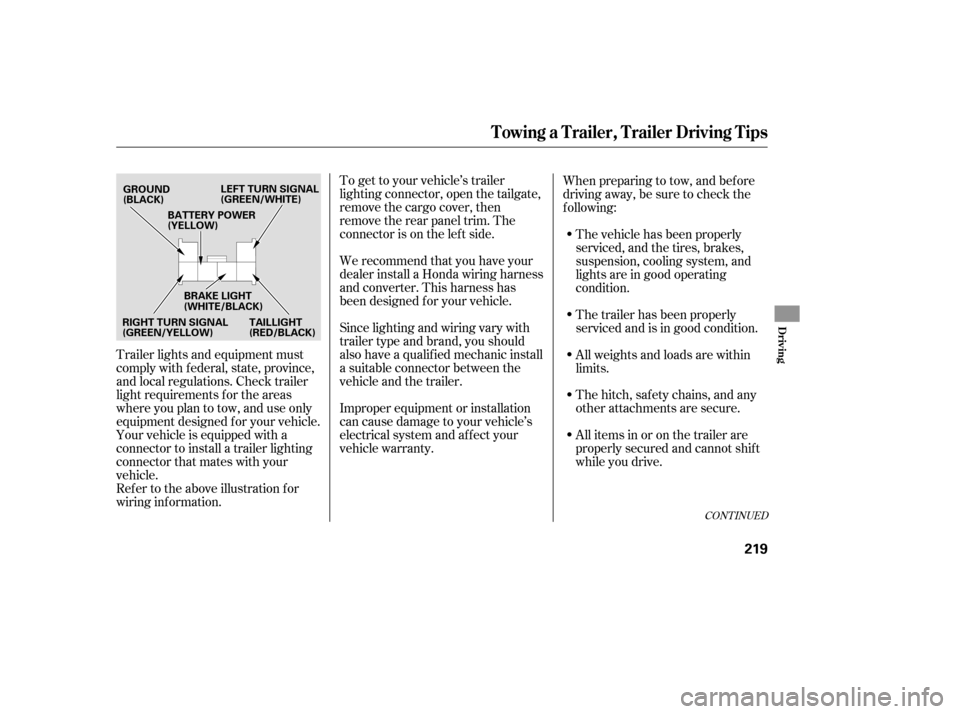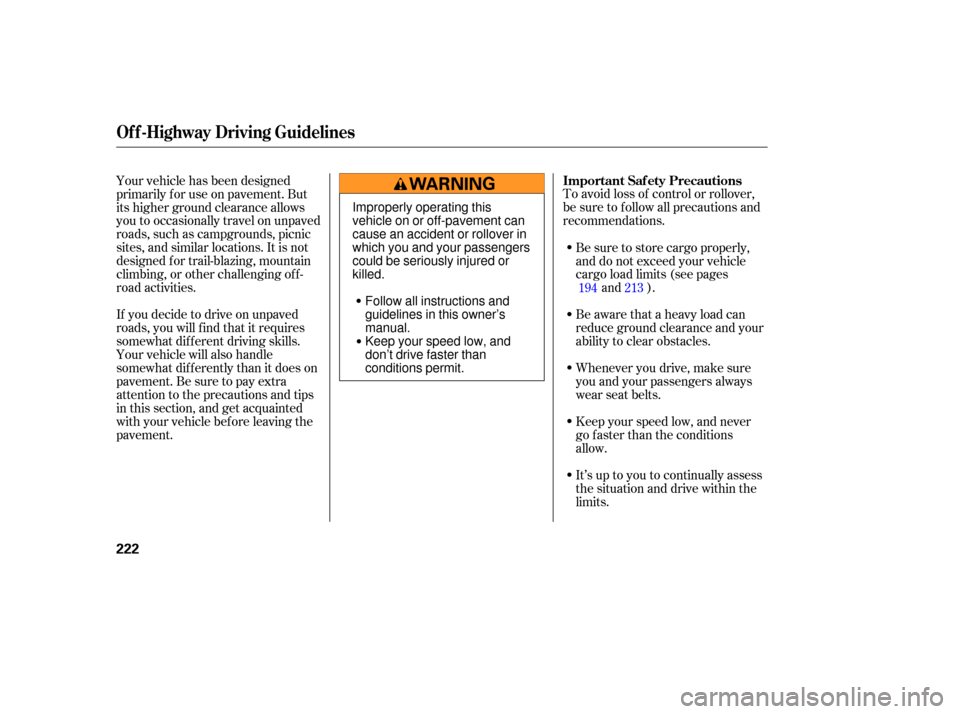HONDA PILOT 2007 1.G Owners Manual
Manufacturer: HONDA, Model Year: 2007, Model line: PILOT, Model: HONDA PILOT 2007 1.GPages: 319, PDF Size: 4.53 MB
Page 221 of 319

Honda requires that any trailer with
a total trailer weight of 1,000 lbs (455
kg) or more has its own brakes.
There are two common types of
trailer brakes: surge and electric.
Surge brakes are common for boat
trailers, since the brakes will get wet.
If you choose electric brakes, be
sure they are electronica lly actuated.
Do not attempt to tap into your
vehicle’s hydraulic system. No
matter how successful it may seem,
any attempt to attach trailer brakes
to your vehicles hydraulic system
will lower braking effectiven ess and
create a potential hazard. Always
use safety chains when you
tow a trailer. Make sure the chains
are secured to the trailer and hitch,
and that they cross under the tongue
and can catch the trailer if it
becomes unhitched. Leave enough
sl ack to allow the trailer to turn
co rners easily, but do not let the
ch ains drag on the ground.
This device is recommended if your
trailer tends to sway. Your trailer
maker can tell you what kind of sway
control you need and how to install it.
Many states and provinces require
special exterior mirrors when towing
a trailer. Even if they don’t, you
should install special mirrors if you
cannot clearly see behind you, or if
the trailer creates a blind spot. When
towing a trailer, we
recommend that you carry a full-size
spare wheel and tire for your vehicle
and trailer. See page for proper
tire size, page for how to store a
full size wheel and tire, and page f or inf ormation on changing a
flat tire.
Remember to unhitch the trailer
bef ore changing a f lat. Ask your
trailer sales or rental agency where
and how to store the trailer’s spare
tire.
Seeyourtrailerdealerorrental
agency f or more inf ormation on
installing electric brakes. 267
258
270
Towing a Trailer
Trailer Brakes Saf ety Chains
Sway Cont rolTrailer Mirrors Spare Tires
218
Page 222 of 319

To get to your vehicle’s trailer
lighting connector, open the tailgate,
remove the cargo cover, then
remove the rear panel trim. The
connector is on the lef t side.
Trailer lights and equipment must
comply with f ederal, state, province,
and local regulations. Check trailer
light requirements f or the areas
where you plan to tow, and use only
equipment designed f or your vehicle.
Your vehicle is equipped with a
connector to install a trailer lighting
connector that mates with your
vehicle.
Ref er to the above illustration f or
wiring information. We recommend that you have your
dealer install a Honda wiring harness
and converter. This harness has
been designed f or your vehicle.
Since lighting and wiring vary with
trailer type and brand, you should
also have a qualif ied mechanic install
a suitable connector between the
vehicleandthetrailer.
Improper equipment or installation
can cause damage to your vehicle’s
electrical system and af f ect your
vehicle warranty.When preparing to tow, and bef ore
driving away, be sure to check the
f ollowing:
The vehicle has been properly
serviced, and the tires, brakes,
suspension, cooling system, and
lights are in good operating
condition.
The trailer has been properly
serviced and is in good condition.
All weights and loads are within
limits.
Thehitch,safetychains,andany
other attachments are secure.
All items in or on the trailer are
properly secured and cannot shif t
while you drive.
CONT INUED
Towing a Trailer, Trailer Driving Tips
Driving
219
GROUND
(BLACK) LEFT TURN SIGNAL
(GREEN/WHITE)
RIGHT TURN SIGNAL
(GREEN/YELLOW) BRAKE LIGHT
(WHITE/BLACK)
TAILLIGHT
(RED/BLACK)
BATTERY POWER
(YELLOW)
Page 223 of 319

Your vehicle tires and spare are
properly inflated, and the trailer
tires and spare are inflated as
recommended by the trailer
maker.
To wing performance can be
affected by high altitude, high
te mperature, or when climbing
steep grades. Therefore, premium
fuel (premium unleaded gasoline
wi th pump octane number of 91 or
higher) is recommended when
towing more than 3,500 lbs (1,590
kg).
The added weight, length, and
height of a trailer will affect your
vehicl e’s handling and performance,
so driving with a trailer requires
some special driving skills and
techniques. Foryoursafetyandthesafetyof
others,taketimetopracticedriving
maneuvers
before heading for the
open road, and follow the guidelines
below.
Avoid towing a trailer during your
vehicle’s f irst 600 miles (1,000 km)
(see page ).
Drive slower than normal in all
driving situations, and obey posted
speed limits f or vehicles with trailers.
When towing a f ixed-sided trailer
(e.g., camper), do not exceed 55 mph
(88 km/h). At higher speeds, the
trailer may sway or affect vehicle
handling.
To prevent the transmission f rom
shif ting f requently, drive in the D
position. Maketurnsmoreslowlyandwider
than normal. The trailer tracks a
smaller arc than your vehicle, and it
canhitorrunoversomethingthe
vehicle misses. Allow more time and
distance f or braking. Do not brake or
turn suddenly as this could cause the
trailer to jackknif e or turn over.
When climbing hills, closely watch
your temperature gauge. If it nears
the red (Hot) mark, turn the air
conditioning of f , reduce speed and, if
necessary, pull to the side of the
road to let the engine cool.
If the automatic transmission shif ts
f requently while going up a hill, shif t
to D .
186
3
Trailer Driving Tips
Driving Saf ely With a T railer
Break-In Period
T owing Speeds and Gears Making T urns and Braking
Driving on Hills
220
Page 224 of 319

When driving down hills, reduce
your speed and shift down to D . Do
not ‘‘ride’’ the brakes.
If you must stop when facing uphill,
use the foot brake or parking brake.
Do not try to hold the vehicle in
placebypressingontheaccelerator,
as this can cause the automatic
transmission to overheat.
Crosswinds and air turbulen ce
caused by passing trucks can disrupt
your steering and cause trailer to
sway. When being passed by a large
vehicle, keep a constant speed, and
steer straight ahead. Do not try to
make quick steering or braking
corrections. Al
ways drive slowly and have
someone guide you when backing up.
Grip the of the steering
wheel; then turn the wheel to the left
to get the trailer to move to the left,
andturnthewheel righttomovethe
trailer to the right.
Follow all norm al precau tions when
parking, including putting the
transmission in Park and firmly
setting the parking brake. Also, place
wheel chocks at each of the trailer’s
tires.
If the vehicle’s tires slip when
retr ieving a boat from the water,
shift to first gear, and turn on VTM-4
lock (see page ). Disengage
VTM-4 lock as soon as the boat is
out of the water to prevent damage
to the VTM-4 system. Your
vehicle is not designed to be
towed behind a motor home. If your
vehicle needs to be towed in an
emergency, see page .
204 279
3
bottom
Remember, it
takes longer to slow down and
stop when towing a trailer. Towing Your Vehicle
Handling Crosswinds and Buf f et ingBacking Up
ParkingRet rieving a Boat
T railer Driving T ips, T owing Your Vehicle Behind a Motorhome
Driving
221
Page 225 of 319

To avoid loss of control or rollover,
be sure to follow all precau tions and
recommendations.
Be aware that a heavy load can
reduce ground clearance and your
ability to clear obstacles.
Keep your speed low, and never
go faster than the conditions
allow.
It’s up to you to continually assess
the situation and drive within the
limits.
Your
vehicle has been designed
primarily for use on pavement. But
its higher ground clearance allows
you to occasionally travel on unpaved
roads, such as campgrounds, picnic
sites, and similar locations. It is not
designed for trail-blazing, mountain
climbing, or other challenging off-
road activities. Be sure to store cargo properly,
and do not exceed your vehicle
cargo load limits (see pages
and ).
Whenever you drive, make sure
you and your passengers always
wear seat belts.
If you decide to drive on unpaved
roads, you will f ind that it requires
somewhat dif f erent driving skills.
Your vehicle will also handle
somewhat dif f erently than it does on
pavement. Be sure to pay extra
attention to the precautions and tips
in this section, and get acquainted
with your vehicle bef ore leaving the
pavement. 194 213
Important Saf ety Precautions
Of f -Highway Driving Guidelines
222
Improperly operating this
vehicle on or off-pavement can
cause an accident or rollover in
which you and your passengers
could be seriously injured or
killed.
Follow all instructions and
guidelines in this owner’s
manual.
Keep your speed low, and
don’t drive faster than
conditions permit.
Page 226 of 319

Before you leave the pavement, be
sure to do all scheduled maintenance
and service, and inspect your vehicle
f or any problems. Pay special
attention to the condition of the tires,
and check the tire pressures.
After you return to the pavement,
caref ully inspect your vehicle to
make sure there is no damage that
could make driving it unsaf e.
Recheck the condition of the tires
and the tire pressures.
The route presents limits (too steep
or bumpy roads). You have limits
(driving skill and comfort). And your
vehicle has limits (traction, stability,
and power).
Driving of f -highway can be
hazardous if you f ail to recognize
limits and take the proper
precautions.Forbettertractiononallsurfaces,
accelerate slowly and gradually build
up speed. If you try to start too fast
on wet soil, mud, snow, or ice, you
might not have enough traction to
get underway, and you may dig
yourself a hole. Starting with the
shif t lever in second (2) gear will
help you have a smoother start on
snow or ice.
Debris in the road can damage your
suspension or other components.
Because your vehicle has a high
center of gravity, driving over a large
obstacle, or allowing a wheel to drop
into a deep hole can cause your
vehicle to tip or roll over.
If you can’t clearly see all conditions
or obstacles on a slope, walk the
slope bef ore you drive on it. If you
have any doubt whether or not you
can saf ely drive on the slope, don’t
do it. Find another route.
If you are driving up a hill and f ind
that you cannot continue,
. Your vehicle could roll
over. Slowly back down the hill,
f ollowing the same route you took up
the hill.
Keep in mind that you will usually
need more time and distance to
brake to a stop on unpaved surf aces.
Avoid hard braking. Do not ‘‘pump’’
the brakes; let the anti-lock braking
system pump them f or you.
do not try to
turn around
Check Out Your Vehicle
Remember A ccelerating and Braking A voiding Obstacles
Driving on Slopes
Of f -Highway Driving Guidelines
Driving
223
Page 227 of 319

If you get stuck, engage the VTM-4
Lock (see page ). Carefully try to
go in the direction (f orward or
reverse) that you think will get you
unstuck. Do not spin the tires at high
speeds. It will not help you get out
and may cause damage to the
transmission or VTM-4 system.
If you are still unable to f ree yourself ,
your vehicle is equipped with f ront
and rear tow hooks designed f or this
purpose.
Bef ore driving through water, stop,
get out if necessary, and make sure
that:
The water is not deep enough to
cover your wheel hubs, axles, or
exhaust pipe. You could stall and
not be able to restart your engine.
The water can also damage
important vehicle components.
The banks are sloped so you can
drive out.
The water is not f lowing too f ast.
Deep rushing water can sweep you
downstream. Even very shallow
rushingwatercanwashthe
ground f rom under your tires and
cause you to lose traction and
possibly roll over.
The banks and surf ace under the
water provide good traction. The
water may hide hazards such as
rocks, holes, or mud. If you decide it is saf e to drive
through water, choose a suitable
speed and engage the VTM-4 Lock.
Proceed without shif ting or changing
speeds, and do not stop the vehicle
or shut of f the engine.
After driving through water, test
your brakes. If they got wet, gently
‘‘pump’’ them while driving slowly
until they operate normally.
If the water is deeper than the wheel
hubs, some additional service may
be required. This service is not
covered by your warranties.
Use a nylon strap to attach your
vehicle to the recovery vehicle, and
caref ully take out the slack in the
strap. Once the strap is tight, the
recovery vehicle should apply f orce.
Remember that the recovery vehicle
needs good traction to avoid
becoming stuck, too.204
If You Get Stuck
Crossing a Stream
Of f -Highway Driving Guidelines
224
Page 228 of 319

You should never use a jack to try to
get unstuck. Your vehicle could
easily slip of f the jack and hurt you
or someone else.You may be able to safely tow a
lightweight trailer (such as a
motorcycle or small tent trailer) of f -
road if you f ollow these guidelines.
Do not exceed 1,000 lbs (450 kg)
or a tongue weight of 100 lbs (45
kg).
Stay on smooth, level dirt roads,
and avoid driving in hilly terrain.
Allow extra room f or starting,
stopping, and turning.
Slow down if you encounter bumps
or other obstacles.
Towing a Trailer Off-Road
Of f -Highway Driving Guidelines
Driving
225
Page 229 of 319

Page 230 of 319

If you have the skills and tools to
perform more complex maintenance
tasks on your vehicle, you may want
to purchase the service manual. See
page f or inf ormation on how to
obtain a copy, or see your dealer. This section also includes
instructions on how to read the
maintenance messages in the
inf ormation display, a maintenance
record, and instructions f or simple
maintenance tasks you may want to
take care of yourself . This section explains why it is
important to keep your vehicle well
maintained and how to f ollow basic
maintenance saf ety precautions. ......................
Maintenance Saf ety .228
....................
Maintenance Minder .229
....................
Maintenance Record .236
..............................
Fluid Locations .238
........................
Adding Engine Oil .239
.........
Changing the Oil and Filter .240
..............................
Engine Coolant .242
....................
Windshield Washers .243
....
Automatic Transmission Fluid .244
..............................
Dif f erential Oil .245
....................................
Timing Belt .245
....................................
Brake Fluid .246
....................
Power Steering Fluid .247
.............................................
Lights .248
.....................................
Floor Mats .254
.......................
Cleaning Seat Belts .254
.................................
Wiper Blades .255
...........................................
Wheels .257
...............................................
Tires .257
...................
Checking the Battery .262
.............................
Vehicle Storage .263
305
Maintenance
Maint enance
227